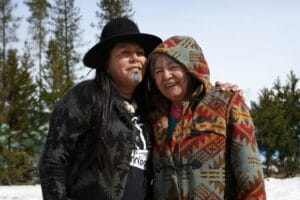Indigenous Women, Girls, and 2SLGBTQQIA+ Individuals Must Be Protected in Canada

The highest rates of femicide in Canada are now experienced by Indigenous women, girls, and 2SLGBTQQIA+ people. In comparison to non-Indigenous women and girls, they are six times more likely to go missing or be murdered, accounting for 16% of all femicide victims and 11% of all missing women.
In 2019, the National Inquiry into Missing and Murdered Indigenous Women, Girls, and 2SLGBTQQIAA+ People’s Final Report thoroughly examined the particular risks that Indigenous women, girls, and 2SLGBTQQIAA+ people face due to anti-Indigenous racism, sexual and gender-based violence, and structural discrimination through colonial structures like residential schools, the Sixties Scoop, the Indian Act, mass incarceration, police brutality, and inequities in transportation and social services.
The exposure of Indigenous women and girls to assault, exploitation, and systemic discrimination has increased dramatically due to a lack of accessible and secure transit options.
Violence Against Indigenous Women and Defenders of the 2SLGBTQQIA+
When it comes to the extensive and extensive exploitation of oil, gas, and other resources across Canada, not enough is being done to address violence against Indigenous women and girls. On the frontlines of land and water defense, Indigenous women and 2SLGBTQQIA+ defenders also experience discrimination, sexual and gender-based assault, and widespread and targeted surveillance.
The 2021 Missing and Murdered Indigenous Women, Girls, and 2SLGBTQQIA+ People National Action Plan was released two years after the National Inquiry into Missing and Murdered Indigenous Women and Girls’ (MMIWG2S+) final report, which has drawn criticism from Amnesty International.
Recognizing the Victimization and Violence Experiences of Indigenous Women and Girls

Compared to non-Indigenous women and girls, Indigenous women and girls are not only far more likely to experience specific acts of violence, but they are also more likely to be victims or survivors of crime.
These consist of domestic violence, sexual assault, and physical assault. Risk variables typically linked to victimization, such as childhood abuse, social dysfunction in one’s neighborhood, homelessness, drug use, or poor mental health, cannot adequately account for the higher incidence of violent victimization among Indigenous women and girls. Being Indigenous is a risk factor for violent victimization of Indigenous women, even after adjusting for this and other risk factors.
Violence Against Indigenous Girls and Women
The most common cause of violent victimization for women is intimate partner violence, which accounts for 45% of all violent occurrences that are reported to the police. Women are more likely than anyone else to be victims of violence committed by a family member, according to data collected by the police. However, compared to non-Indigenous women and girls, Indigenous women and girls are far more likely to experience intimate partner or other family violence, and these acts are frequently more frequent and more severe.
Violence outside the house and a high frequency of attacks from people they may hardly know pose a bigger threat to Indigenous women and girls’ safety than non-Indigenous women and girls, even though intimate relationships and family violence are common threats.
Indigenous Women and Girls Are Missing
The person is promptly located uninjured, and there is no evidence of foul play in the majority of missing persons instances reported to the police. However, attempts to link homicides and missing person cases discovered that up to one in five female homicides involved a victim who had previously been reported missing to the authorities.
When it comes to long-term, unresolved missing persons situations, Indigenous women and girls are disproportionately represented. Other missing Indigenous women and girls instances may have been mistakenly classified as non-Indigenous due to police data restrictions, thereby increasing the number of cases.
